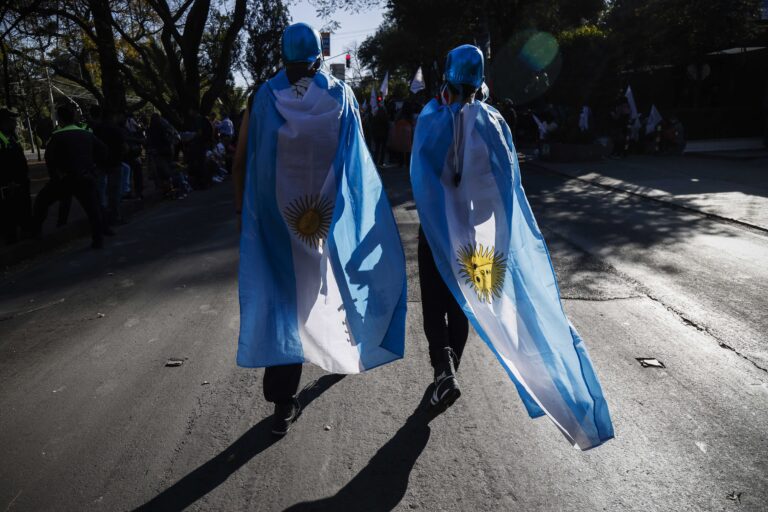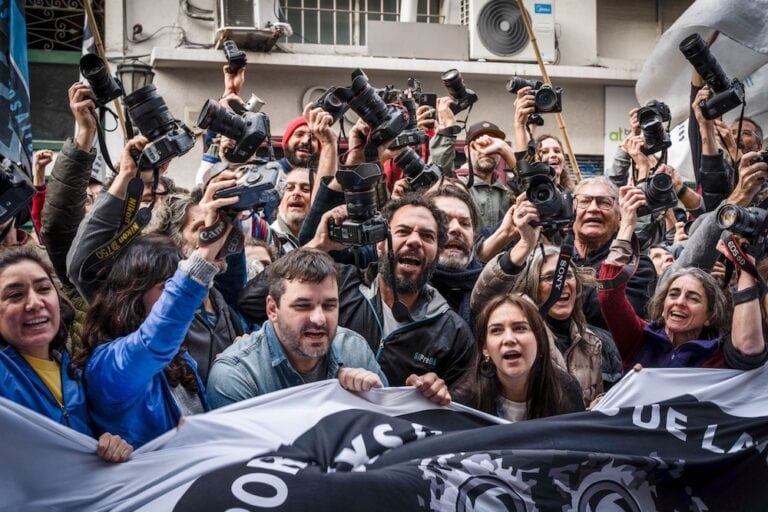(Periodistas/IFEX) – The investigation of press businessman Ricardo Gangeme’s death is distancing itself from his journalistic work and becoming more focused on his private life. Gangeme was assassinated on Thursday, 13 May 1999 in the city of Trelew, in southern Argentina. **Updates IFEX alerts of 17 May, 14 May and 13 May 1999; for background […]
(Periodistas/IFEX) – The investigation of press businessman Ricardo
Gangeme’s death is distancing itself from his journalistic work and becoming
more focused on his private life. Gangeme was assassinated on Thursday, 13
May 1999 in the city of Trelew, in southern Argentina.
**Updates IFEX alerts of 17 May, 14 May and 13 May 1999; for background on
the assassination of journalist José Luis Cabezas see alerts of 26 January
1999, 14 December and 30 January 1998, and others**
The judge in charge of the case, Florencio Minatta, affirmed that the
emphasis on Gangeme’s personal relations “is an important hypothesis.” In
the last few days, the inquiry has been aimed at Trelew’s night life. As a
result, the original hypothesis, that pointed to businessman Héctor
Fernandes’ role in the crime, has been weakened. “This is not another
Cabezas case,” said officer Rubén Lopez Oliver, chief of the Trelew Regional
Unit of the Chubut Police [for background on the Cabezas case, see IFEX
alerts].
Background Information
Gangeme, 56, was the editor of the weekly magazine “El Informador
Chubutense”. He was assassinated by a bullet to the head, in the early hours
of Thursday, 13 May, as he was returning home after having been out for a
coffee with friends. He was parking his car when he was killed, and his body
was found inside the vehicle. At first, investigators assumed that the crime
was connected to his profession, but have more recently decided to focus on
his private life.
Born on 24 August 1943, Gangeme began his journalistic career when he was
fourteen, working for the weekly magazine “Que”. After that, he worked on
the editorial staff of the “Democracia” daily, and later for
“Intransigente”. At the age of 20 he began working on the daily “Cronica”‘s
police files, becoming editor of its evening edition from 1972 until 1988.
He was considered by many as a hard, inflexible and adversarial man, who was
always armed and surrounded by controversy. He was also involved in the arts
business and produced variety shows during the summer season. After he left
“Cronica” on not very amicable terms, he worked for various media until, in
1992, he ended up working on the editorial staff of the Trelew daily
“Jornada”. “Jornada” owner Juan Carlos Spadone entrusted him with improving
the magazine’s profile.
In a political gossip column, which Gangeme signed as “El Fantasmita” (the
Little Ghost), he wrote about the private lives of officials and
businessmen, making various enemies among them in the process. In March
1998, he severed his connection with “Jornada”, to take on a personal
project that took shape in December 1998: the weekly magazine “El Informador
Chubutense”. Further accentuating the adversarial style he was known for by
now, he reported on scandals and walked a fine line between controversy and
sensationalism. One section of the magazine called “Garganta Profunda” (Deep
Throat) was the new incarnation of the “Little Ghost” column, and revealed
the intimate affairs of the most well known personalities.
These kind of articles were thought to have been behind a kidnapping that
took place three years ago, from which Gangeme escaped by throwing himself
out of his captors’ car. A more recent version of events suggests that
Gangeme was using his articles to blackmail the persons named in them. A
friend of his denied this accusation but admitted that “El Informador”
received financial support from a sector of the justice department for the
regular publication of certain accusations. One such allegation was that
businessman Héctor Fernandes was involved in irregularities in connection
with a contract with the Trelew electrical company.
Fernandes denied having made death threats to Gangeme a few days before he
was killed (see IFEX alert of 14 May 1999). He further noted that up to a
little more than a year ago they were friends, and Gangeme introduced him to
Spadone, who became Fernandes’ business partner and friend. Nevertheless,
when in 1998 the journalist left the “Jornada” daily, he accused Fernandes
of having played a role in his dismissal. The businessman denied this but
admitted to having recommended Gangeme’s replacement.
Although these facts point to Fernandes as a suspect, judge Minatta
recognised that because of the victim’s “multifaceted” character, there are
numerous hypotheses to be investigated. The judge decided to examine aspects
of Gangeme’s private life, and to inspect his house and the area where he
lived. “The victim is not an ordinary person, he lived an extravagant public
life, he moved in different social circles,” Minatta explained. “We carried
out searches in some of the night spots the victim used to frequent, and
some persons were detained and questioned about background facts or other
useful information.”
On the night of Saturday 15 May, during a police operation at two night
clubs that were frequented by Gangeme, the police held eighteen people for
questioning. One person testified that between 1 and 1:30 a.m. on the night
of the crime, they saw a person in the path in front of Gangeme’s building
that matched the description of the suspect (according to various accounts,
the assassin was wearing a windbreaker or a red sports jacket with jeans).
Based on these descriptions, the police made a public description of the
suspect on Sunday 16 May. On Monday 17 May, the investigators searched for
the crime weapon and judge Minatta ordered the confiscation of all of
Gangeme’s work papers and personal documents held at the “El Informador
Chubutense” office. Despite these developments in the investigation, there
are still no firm leads as to what really happened in the early morning of
13 May.


